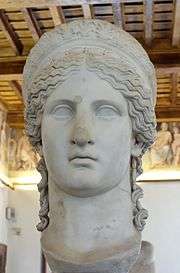Juno Ludovisi
The Juno Ludovisi (also called Hera Ludovisi) is a colossal Roman marble head of the 1st century CE from an acrolithic statue of an idealized and youthful[1] Antonia Minor as the goddess Juno.[2] Added to the Ludovisi collection formed by Cardinal Ludovico Ludovisi, it is now in the Palazzo Altemps, Museo Nazionale Romano, Rome.

The Juno Ludovisi
The Juno Ludovisi
Casts of it are to be seen at the University of Cambridge Classics Dept Casts Gallery.,[3] Bryn Mawr[4] and the Goethehaus in Weimar, Germany [5] and the University of Tartu Art Museum in Estonia. [6]
Notes
- "The coiffure of Antonia's youth is characterized by a central part and round, braided hairknot" (K. Patricia Erhart, "A Portrait of Antonia Minor in the Fogg Art Museum and Its Iconographical Tradition", American Journal of Archaeology 82.2 (Spring 1978:193-212) (online abstract).
- R. Tölle-Kasterbein, "Juno Ludovisi: Hera oder Antonia Minor?" Mitteilungen dI (A), 89 1974.
- Museum of Classical Archaeology
- Susan Wood, "Goddess or woman?"
- Klassikstiftung Weimar, Goethes Wohnhaus
- University of Tartu Art Museum
This article is issued from Wikipedia. The text is licensed under Creative Commons - Attribution - Sharealike. Additional terms may apply for the media files.